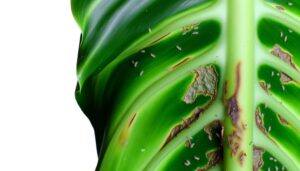How to Make Monstera Albo More Variegated
To increase variegation in your Monstera Albo, place it in bright, indirect light around 10,000-20,000 lumens, for 12-14 hours daily. Guarantee sterile pruning shears and trim less variegated stems above the nodes during spring or summer to balance hormones.
Water every 1-2 weeks, checking soil moisture to avoid root rot. Apply a balanced fertilizer every 4-6 weeks, focusing on nitrogen, phosphorus, and potassium.
Keep the environment warm, around 70-75°F (21-24°C). For propagation, use nodes with variegated leaves and aerial roots.
Regularly inspect for pests and diseases to maintain plant health. Discover more for detailed guidance.
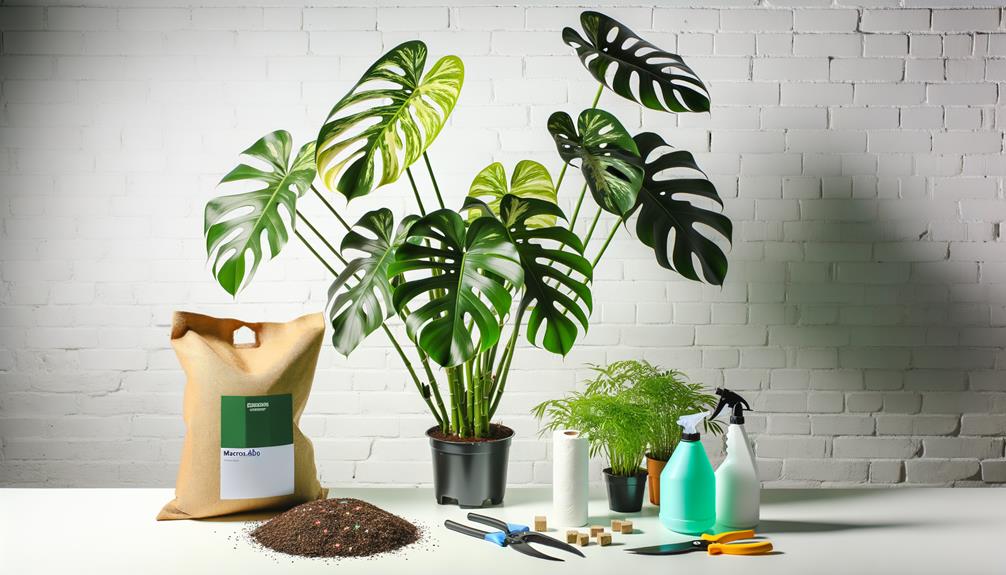
Key Takeaways
- Trim stems with less variegation above the nodes to promote new variegated growth.
- Position the plant in bright, indirect light, ensuring 12-14 hours of light daily.
- Use balanced fertilizer every 4-6 weeks to support healthy growth and variegation.
- Prune during spring or summer to encourage balanced hormone distribution for better variegation.
- Choose nodes with variegated leaves and aerial roots for propagation to enhance variegated traits.
Understanding Variegation
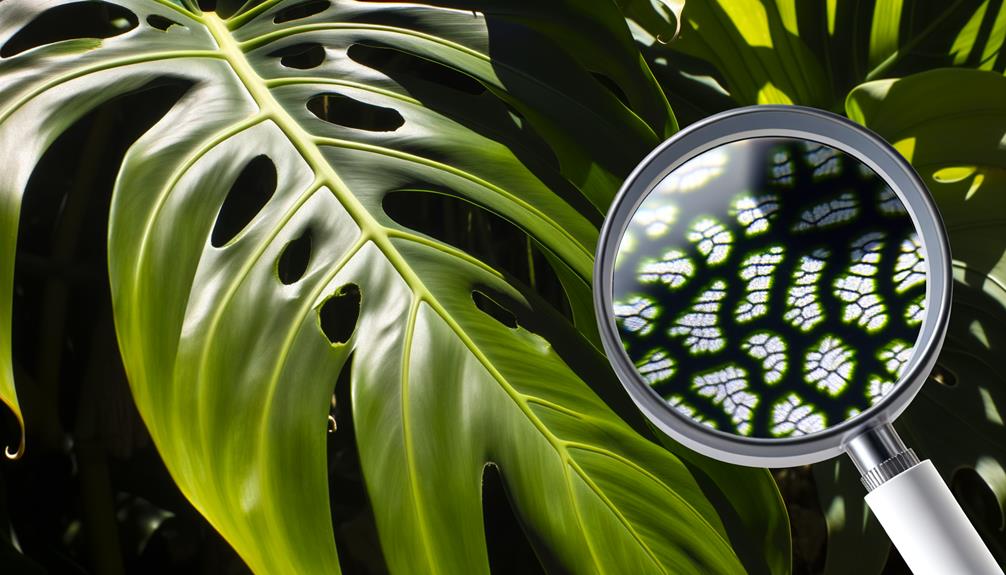
Variegation in Monstera Albo, characterized by distinct white or cream-colored sectors on the leaves, occurs due to genetic mutations affecting chlorophyll production. These mutations lead to areas of the leaf lacking chlorophyll, resulting in white patches.
To understand this, you need to know that chlorophyll is essential for photosynthesis, allowing the plant to convert light energy into chemical energy. Without it, the white areas can't contribute to energy production.
This genetic trait can be unpredictable and can vary significantly between different plants and even leaves on the same plant. If you're aiming to maintain or enhance variegation, you should focus on encouraging these mutations while ensuring the plant's overall health. Careful monitoring and adjustments are key.
Choosing the Right Light
For best variation in Monstera Albo, position the plant in bright, indirect light to make sure it receives sufficient energy without risking leaf burn. Variegated leaves contain less chlorophyll, making them more dependent on ideal light conditions to photosynthesize efficiently.
Consider these key points:
- Light Intensity: Ensure the light source is around 10,000 to 20,000 lumens.
- Light Duration: Provide 12-14 hours of light daily using grow lights if natural light is inadequate.
- Light Source: Avoid direct sunlight, which can scorch leaves, leading to chlorophyll degradation.
Monitor the leaf color regularly. If you notice fading variegation, adjust the light exposure accordingly.
Proper light management is essential for sustaining and enhancing the variegated patterns in your Monstera Albo.
Pruning Techniques
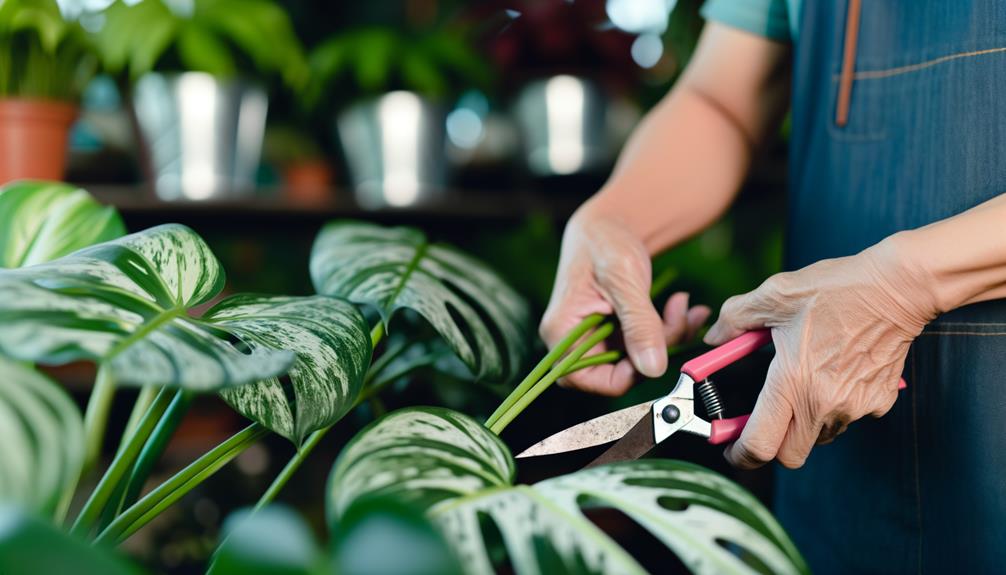
Effective pruning techniques are essential for promoting new growth and enhancing the variegation in your Monstera Albo. Start by sterilizing your pruning shears with rubbing alcohol to prevent disease transmission. Identify stems with less variegation and trim them back to just above a node. This stimulates axillary bud growth, often resulting in new variegated leaves.
Remove any yellow or damaged leaves to allocate the plant's resources more efficiently. Prune during the growing season, typically spring or summer, when the plant's metabolic activities are at their peak. Avoid over-pruning, as this can stress the plant and reduce variegation.
Consistent, careful pruning helps maintain a balanced hormone distribution, promoting the development of the striking white and green foliage you desire.
Proper Watering Practices
Ensuring that your Monstera Albo receives the right amount of water is crucial for maintaining its distinctive variegation and overall health. Proper hydration supports optimal chlorophyll production and cellular function, essential for the plant's variegated leaves.
You should aim for consistent soil moisture without causing waterlogging, which can lead to root rot.
- Check soil moisture: Insert your finger 2 inches into the soil. Water only if it feels dry.
- Watering frequency: Generally, water every 1-2 weeks. Adjust based on your climate and season.
- Drainage importance: Verify your pot has drainage holes to prevent stagnant water.
Fertilization Tips
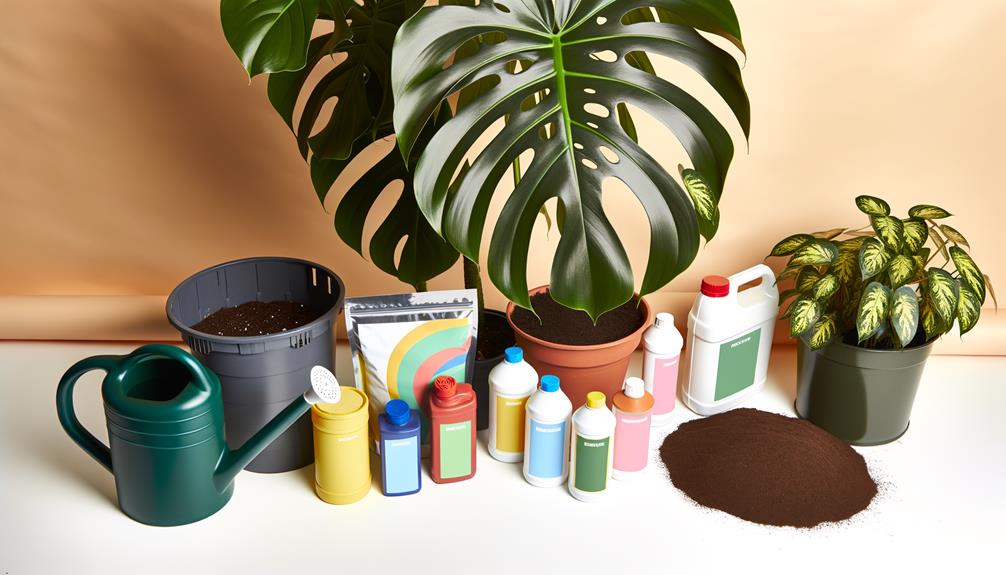
To enhance variegation in your Monstera Albo, you should focus on balanced nutrient ratios, particularly nitrogen, phosphorus, and potassium. Apply a balanced fertilizer every 4-6 weeks during the growing season, ensuring consistent nutrient availability.
Avoid over-fertilization, as it can lead to nutrient imbalances and reduced variegation.
Balanced Nutrient Ratios
Balanced nutrient ratios are necessary for promoting the variegation in Monstera Albo, requiring a meticulous blend of macronutrients like nitrogen, phosphorus, and potassium.
To optimize your plant's variegation, focus on these key elements:
- Nitrogen (N): Essential for foliage growth, but too much can overshadow variegation. Aim for balanced N levels to support healthy leaf development without reducing variegated patterns.
- Phosphorus (P): Important for root development and energy transfer. Adequate phosphorus enhances overall plant vigor, indirectly supporting variegation.
- Potassium (K): Supports photosynthesis and stress resistance. Ensuring sufficient potassium helps maintain the plant's health and encourages vibrant variegation.
Fertilizer Application Frequency
Maintaining ideal variegation in Monstera Albo requires not only the right nutrient balance but also a strategic approach to fertilizer application frequency. Apply a balanced, water-soluble fertilizer every 4-6 weeks during the growing season (spring and summer). This frequency guarantees the plant receives consistent nutrient supply, promoting robust growth and preserving variegation.
In the dormant period (fall and winter), reduce applications to every 8-10 weeks or suspend entirely to prevent nutrient overload. Over-fertilization can lead to root burn and diminish variegation. Monitor soil moisture before application; slightly moist soil optimizes nutrient uptake.
Adhering to this schedule supports chlorophyll stability, enhancing the white and green contrasts in your Monstera Albo's foliage.
Temperature and Humidity
Achieving peak variegation in Monstera Albo requires maintaining a consistent temperature range between 65°F and 80°F, with humidity levels ideally above 60%. These conditions optimize the plant's physiological processes, enhancing chlorophyll production and stabilizing variegation patterns.
To ensure best temperature and humidity:
- Invest in a hygrometer: This device measures humidity, helping you maintain the ideal environment.
- Use a humidifier: A humidifier can sustain the necessary moisture levels, especially in dry climates or during winter months.
- Place plants in a bathroom or kitchen: These rooms often have naturally higher humidity levels, beneficial for your Monstera Albo.
Soil and Potting Mix
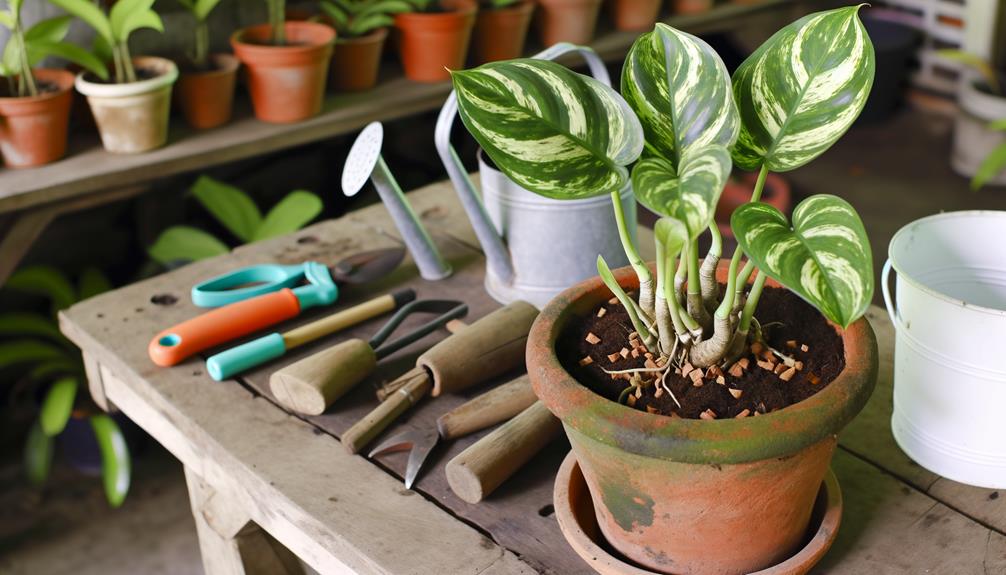
To further nurture your Monstera Albo's variegation, you'll need a well-aerated soil and potting mix that promotes proper drainage and nutrient retention. Start by combining equal parts of high-quality peat moss, perlite, and orchid bark. This mixture enhances soil aeration and guarantees roots receive adequate oxygen. Additionally, incorporating activated charcoal helps absorb toxins, maintaining a healthier root environment.
Guarantee the soil pH remains slightly acidic, around 5.5 to 6.5, to optimize nutrient uptake. Avoid compacted soil, as it can suffocate roots and impede growth. Regularly check for soil moisture; it should be moist but not waterlogged.
Proper soil and potting mix management will bolster your Monstera Albo's variegation, promoting vibrant, white and green foliage.
Propagation Methods
To propagate your Monstera Albo and enhance its variegation, you'll focus on the stem cuttings technique and the air layering process.
Start by selecting nodes with strong variegation patterns, ensuring best chlorophyll distribution. For stem cuttings, use sterilized tools to make clean cuts just below a node.
For air layering, create a small incision and wrap it with moist sphagnum moss.
Stem Cuttings Technique
By mastering the stem cuttings technique, you'll enhance your chances of successfully propagating a more variegated Monstera Albo. Begin by selecting a healthy stem with at least one node and variegated leaves. Use sterilized pruning shears to make a clean cut below the node. Place the cutting in water or a well-draining soil mix to encourage root development.
Here's what you need to guarantee:
- Humidity: Maintain high humidity around the cutting to prevent desiccation.
- Light: Provide bright, indirect light to facilitate photosynthesis without causing leaf burn.
- Temperature: Keep the environment warm, ideally between 70-75°F (21-24°C), to accelerate root growth.
Monitor the cutting regularly, and within a few weeks, you should observe new roots forming.
Air Layering Process
Often employed by horticulturists, air layering is a propagation method that encourages root formation directly on the parent plant, ensuring a higher likelihood of success for your Monstera Albo.
To start, select a healthy section of the stem. Make a small incision below a node, about one-third of the stem's circumference. Apply rooting hormone to the cut to stimulate root development.
Wrap moist sphagnum moss around the cut and cover it with plastic wrap to retain moisture. Secure the setup with twist ties. Over time, roots will form within the moss.
Once substantial roots have developed, carefully cut below the rooted section and pot it in soil. This method maintains the plant's variegation, enhancing its aesthetic appeal.
Node Selection Tips
Selecting the right node is important for successful propagation, as a node contains the plant's meristematic tissue, which is necessary for new growth.
When choosing a node on your Monstera Albo, focus on the following aspects:
- Variegation: Opt for nodes with visible variegated leaves. These nodes have a higher chance of producing variegated offspring.
- Health: Ensure the node is free from disease or damage. Healthy nodes are essential for robust growth and development.
- Aerial roots: Select nodes with aerial roots or root initials. These structures enhance the likelihood of successful rooting during propagation.
Monitoring Plant Health
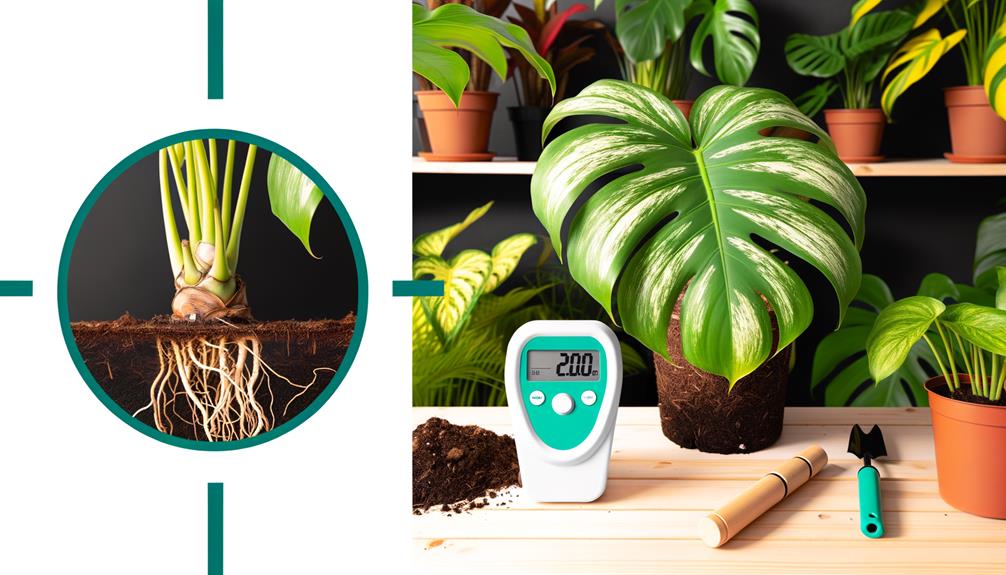
Regularly inspecting the Monstera Albo for signs of pests, disease, and nutrient deficiencies is essential to ensuring best plant health and promoting variegation.
Examine the leaves for chlorosis, which indicates nutrient deficiencies. Variegated leaves are more susceptible to chlorosis due to reduced chlorophyll.
Check for necrosis, which may suggest overwatering or underwatering. Monitor the stems for any signs of rot, often caused by poor drainage.
Assess the soil's moisture levels using a hygrometer to avoid water stress. Observe root health by carefully loosening the soil and inspecting for root rot or pest infestations.
Regular pruning of damaged or unhealthy leaves can enhance overall plant vigor and encourage more variegated growth. Consistent health checks will optimize variegation.
Avoiding Pests and Diseases
To prevent pests and diseases, you should implement a regular inspection routine to identify issues early.
Use proper watering techniques to avoid root rot and fungal infections by ensuring the soil has adequate drainage.
Employ effective pest control methods, such as neem oil or insecticidal soap, to protect your Monstera Albo's variegation.
Regular Inspection Routine
Conduct thorough weekly inspections of your Monstera Albo to promptly identify and address any signs of pests or diseases that could compromise its variegation and overall health. Examine both the adaxial and abaxial surfaces of the leaves, focusing on common pests like spider mites, aphids, and scale insects. Check for discoloration, deformities, or necrotic spots indicative of fungal or bacterial infections.
- Use a magnifying glass: This helps you spot tiny pests and early signs of disease.
- Inspect the stem and nodes: Look for any abnormalities or growths.
- Monitor new growth: Any irregularities can be an early warning sign.
Proper Watering Techniques
Guaranteeing proper watering techniques is crucial in maintaining the health and variegation of your Monstera Albo. Overwatering can result in root rot and attract pests like fungus gnats. Monitor soil moisture by inserting your finger into the top inch of soil. Water only when it feels dry.
Utilize a well-draining potting mix to prevent water accumulation around the roots. Avoid letting the plant sit in excess water by emptying the saucer beneath the pot. Confirm that the pot has drainage holes to facilitate proper water flow.
Consistent, moderate watering mimics the Monstera's natural tropical habitat, aiding in nutrient absorption and overall plant vigor. This physiological approach supports vibrant variegation and minimizes susceptibility to diseases and pests.
Effective Pest Control
Maintaining a pest-free environment for your Monstera Albo involves regular inspections and immediate intervention at the first sign of trouble. Examine leaves for signs of pests like spider mites, aphids, and mealybugs. Use a magnifying glass for thorough scrutiny.
To effectively manage pests:
- Neem Oil: Apply a diluted solution of neem oil to the foliage. It disrupts pests' hormonal systems.
- Insecticidal Soap: This is effective against soft-bodied insects. Spray directly on affected areas.
- Systemic Pesticides: For severe infestations, systemic pesticides are absorbed by the plant, killing pests that feed on it.
Ensure proper air circulation to prevent fungal growth.
Quarantine new plants to avoid introducing pests.
Regularly clean leaves to remove dust, which can harbor pests.
Patience and Consistency
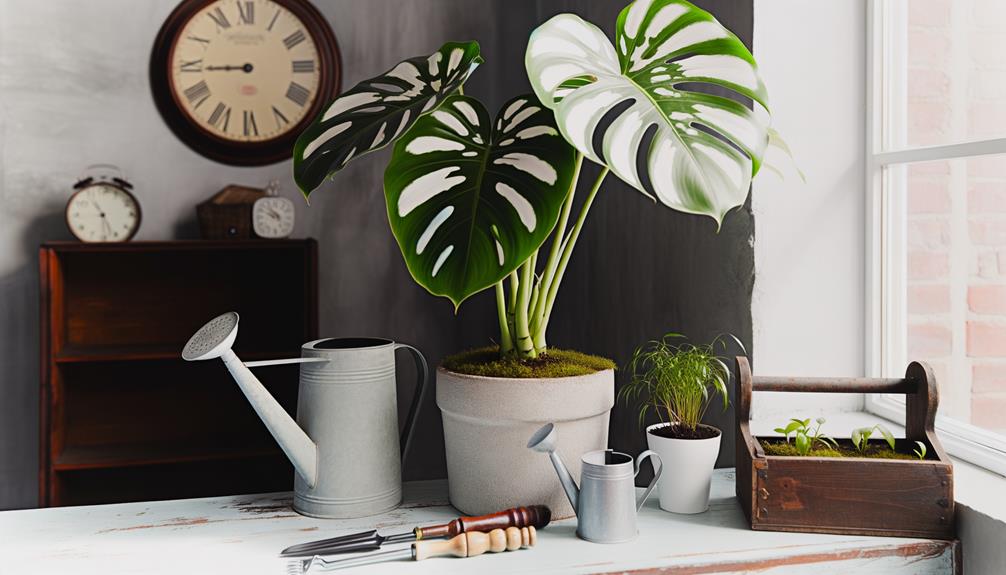
Achieving greater diversity in your Monstera Albo requires patience and consistent care, as the plant's phenotypic expression relies heavily on stable environmental conditions and precise attention to its needs. Monitor its light exposure, as variegated leaves need bright, indirect light to thrive. Maintain ideal humidity and steady watering practices to prevent stress, which can reduce diversity. Regularly check for nutrient imbalances and correct them promptly. Here's a quick reference table:
| Care Aspect | Requirements | Impact on Diversity |
|---|---|---|
| Light Exposure | Bright, indirect light | Promotes diversity |
| Humidity | 60-80% | Prevents leaf browning |
| Watering | Consistent, moderate | Avoids stress, maintains health |
| Nutrient Balance | Balanced fertilizer bi-monthly | Supports healthy growth |
Stay diligent and your Monstera will reward you with stunning diversity.
Conclusion
In your journey to enhance your Monstera Albo's variegation, remember: patience is key, like watching paint dry.
By optimizing light conditions, pruning wisely, watering correctly, and fertilizing appropriately, you're setting the stage for success.
Propagate with care, monitor plant health, and fend off pests diligently.
Consistency and attention to detail will eventually reward you with striking, variegated foliage that's the envy of any plant enthusiast.
Keep nurturing, and nature will do the rest.



